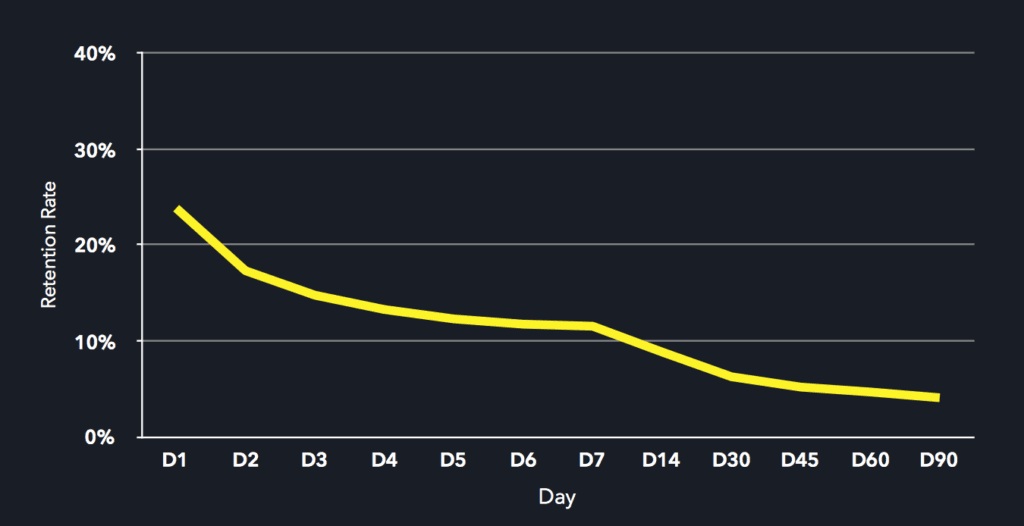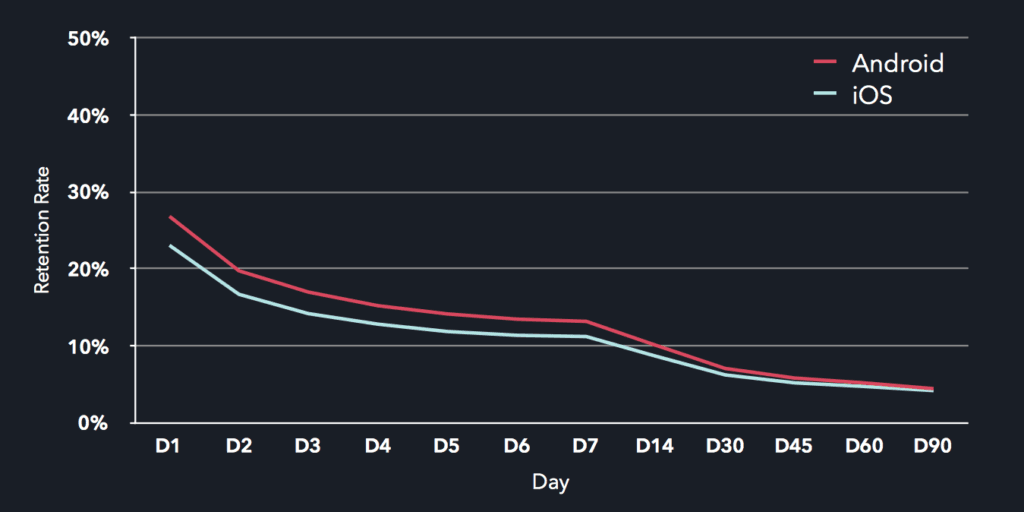App User Retention: Less Than 25% of New App Users Return the Day After First Use (Here’s What to Do About It)
Published on May 19, 2016/Last edited on May 19, 2016/8 min read


Todd Grennan
Content Production Principal, Content Marketing at BrazeYour customers are the core of your business. No matter how good your products are, or how compelling your brand story, if you can’t get your audience to stick around and build rich, durable relationships with your brand, you’re going to be at a major competitive disadvantage in today’s complex, rapidly-changing world.
Understanding your app’s retention rate and how it stacks up to the benchmark rates seen in your vertical and across the larger mobile ecosystem is an essential part of figuring out your customer engagement and retention strategy. After all, it’s hard to get where you have to go if you don’t know where you currently are or where you need to be.
To support that effort, Appboy is pleased to announce the release of a new data report covering app user retention rates by day (also known as Day N, N-Day, or classic retention numbers). The report is the most comprehensive examination of mobile app retention to date, analyzing data from more than 300 apps globally and more than 300 million user profiles to provide detailed day by day retention data for both iOS and Android apps, broken down by app vertical.
Using Day N retention rates, brands can determine how many new users return on a particular day following their first session. For instance, if 100 customers first use your app on a certain day (Day 0) and 30 of those original 100 return seven days later, that translates to a 30% Day 7 retention rate; similarly, if 20 of the original customers return 30 days later, that’s a 20% Day 30 retention rate. That level of detail makes it possible to pinpoint critical inflection points in user activity, giving brands insight into windows for engagement. In addition, when used in conjunction with other retention metrics, such as three-month return retention, Day N retention statistics can provide insight into when customers are most likely to return.
Here’s what our research found:
- Retaining new app users isn’t easy, with more than 75% of users failing to return the day after first use, on average
- Mobile operating systems and devices matter, with Android apps seeing higher retention through Day 90 in most verticals
- There is no one retention story that fits every vertical—each sees unique user retention trends
As we saw with our three-month return retention report, consistent early engagement is key to increased retention. The steady declines in average user retention over the 90 days following first use that we see in this new report reinforce the importance of keeping your app top of mind.
Download the Spring 2016 Mobile Customer Retention Report
Retaining new app users isn’t easy, with more than 75% of users failing to return the day after first use, on average

It’s no trade secret that retention is often a struggle for mobile apps. But our research found that, for the average app, getting a new user to return even one day after first use isn’t easy—in fact, fewer than 25% of users who first used an app on a given day logged a session with that app the day after. And while some of those users will return in the days that follow, the Day N retention rate continues to trend downward over the three months after first use, hitting 4.1% on Day 90. When you consider the rising expense associated with acquiring new app users—in 2015, customer acquisition costs rose 117% year over year—it can be argued that finding ways to retain a larger share of new users is the most significant factor in whether a brand thrives or fails on mobile.
Mobile operating systems and devices matter, with Android apps seeing higher retention through Day 90

There are notable differences in the levels of engagement shown by users on Android and iOS apps. Overall, retention rates are higher on Android than iOS. During the first week after first use, users of Android apps show higher retention rates day by day, declining from a high of 27% on Day 1 to 13% on Day 7; in comparison, only 23% of new iOS app users log a session on Day 1 and only 11% do so on Day 7.
Android and iOS users have been known to exhibit different behaviors on mobile, with divergent opt-in rates, open and conversion rates, and now with different user retention rates. That means it’s essential for marketers to keep an eye on how their iOS and Android users respond to messaging and engage with their brand—it may be that sending an iOS push won’t have the same results as sending an Android push for certain groups of users.
You can see an example of this difference in the social and messaging vertical. While Android apps tend to have stronger retention than iOS apps, social and messaging apps on iOS consistently outperform their Android equivalents throughout the 90 days following first use and have the highest retention rate of any vertical after three months.
There is no one retention story, and every app vertical sees unique user retention trends
While all 10 app verticals that we examined as part of our retention research saw declines in daily engagement among their new users in the 90 days following first use, every vertical we looked at had its own unique retention trends. It’s normal for different businesses and industries to have customers with different behavior and engagement patterns. The important thing is for brands to understand how they stack up to the average app in their vertical, so they can assess how they’re performing in comparison to rival apps and use that information to inform future strategies and outreach.
Three notable vertical-specific findings emerged:
- Mobile gaming is easily the strongest vertical when it comes to Day 1 retention, with nearly 40% of new users returning the day after first use.
- Android apps often have higher retention rates than their iOS equivalent across many app verticals. The exceptions are social and messaging apps, where iOS consistently outperforms Android, and media and entertainment apps, where iOS overtakes Android after Day 7.
- Food and beverage apps experienced the lowest retention rates during the first week after first use, but saw a unique uptick in engagement on Day 6 and 7, suggesting that a subset of customers could be repeating their behavior with that app on a weekly basis.
Steady declines in average user retention reinforce the importance of keeping your app top of mind
Looking at the steady decline in engagement day by day on both iOS and Android apps and across almost every vertical, it’s clear that, for the average app, retaining new users just isn’t something that happens on its own.
Sometimes an app just isn’t giving its users what they need to keep engaging. But sometimes a great app just doesn’t take the opportunity to win over new users. The longer that a customer goes without engaging, the less likely they are to engage with your app again. And there are so many apps out there—and so many other distractions—that it can be difficult to keep your brand top of mind, especially given that most people spend 80% of their mobile time with their top three apps.
The truth is, retaining customers is often a difficult task. But the customers who are most likely to stick around are the ones who create and maintain a consistent pattern of engagement, turning app usage into a strong habit. That means that brands that provide outreach and a user experience that rewards consistent engagement are well positioned to thrive in today’s fast-changing, mobile-focused world.
How do you get there?
- Create effective onboarding campaigns that educate new customers about the value your of brand and how they can take advantage of it
- Communicate regularly with your customers using multiple outreach channels to keep them involved with your brand and to nudge them to engage more deeply
- Use analytics and monitor your KPIs to identify customers who are beginning to engage less consistently and use your mobile messaging tools to encourage them to return to the fold
If you’re looking for more guidance on retaining customers, check out our blog posts on how brands can boost retention by inspiring more consistent engagement and 10 ways you can optimize your retention efforts.
Download the Spring 2016 Mobile Customer Retention Report
Methodology
Appboy’s retention study looked at more than 300 apps globally on our platform with MAU over 5,000 and analyzed more than 300 million user profiles that first used an app in November and December 2015 across more than 1 billion session from November 2015 through March 2016.
Under the Day N methodology, a day is defined as a 24-hour interval of time following a user’s first session and is calculated for each day independent of what has happened on other days. For instance, if a customer first uses an app at 1:00 p.m. on January 1, then has additional sessions at 12:30 p.m. and 1:30 p.m. on January 3, the 12:30 p.m. activity is considered to have occurred on Day 2, while the 1:30 p.m. activity took place on Day 3.

Related Tags
Be Absolutely Engaging.™
Sign up for regular updates from Braze.




